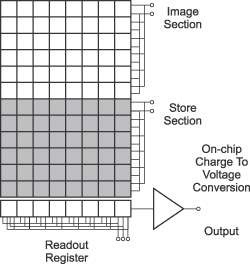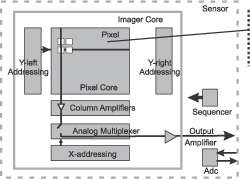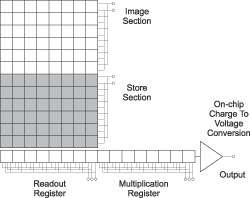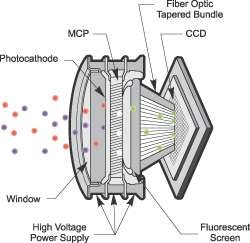Resources
 Part of the Oxford Instruments Group
Part of the Oxford Instruments Group
Expand
Collapse
 Part of the Oxford Instruments Group
Part of the Oxford Instruments Group
The principal forms of high performance scientific camera include:
- The popular Charge-Coupled Device Camera - CCD Camera,
- the Electron Multiplying Charge Coupled Device Camera - EMCCD Camera,
- the complementary-Metal-Oxide-Semiconductor Camera - sCMOS Camera, and;
- the Image Intensified CCD Camera - ICCD Camera.

In the first three detectors, a silicon diode photosensor (often called a Pixel) is coupled to a charge storage region that is, in turn, connected to an amplifier that reads out the quantity of accumulated charge. Incident photons generate electronic charges, which are stored in the charge storage region. If the incident photons have sufficient energy and they are absorbed in the depletion region they liberate an electron which can be detected as a charge. The transmission and absorption properties of the silicon then define the spectral response of the detector and this is explained further in another section.
In a CCD, there is typically only one amplifier at the corner of the entire array and the stored charge is sequentially transferred through the parallel registers to a linear serial register, then to an output node adjacent to the read-out amplifier. CCD sensors were first developed in the late 60's and the technology is relatively mature now. CCD performance has pushed the boundaries in the efficiency of light detection and in reducing the noise from either dark signal or amplifier readout. One weakness of a CCD is the fact that the CCD is essentially a serial readout device and low noise performance is only achieved at the expense of slow readout speeds. CMOS cameras can achieve high frame rates with moderate sensitivity.

In CMOS detectors, each individual photosensor or more typically each column of photosensors has an amplifier associated with it. A row of pixels can be readout in parallel with the row selected by an addressing register or an individual pixel can be selected by column multiplexer. A CMOS device is essentially a parallel readout device and therefore can achieve higher readout speeds particularly required by imaging applications. CMOS detector technology however still needs considerable development to compete against CCD for performance in scientific applications. To achieve the parallel readout the CMOS amplifier uses multiple amplifiers, each with its own gain, linearity and noise performance variation. Compensating for the variations in the current state of the art CMOS devices is difficult over a wide range of illumination levels and to the accuracy required by scientific applications. High speed readout with high sensitivity can be achieved by EMCCD cameras.
The EMCCD has essentially the same structure as a CCD with the addition of a very important feature. The stored charge is transferred through the parallel registers to a linear register as before but now prior to being readout at the output node the charge is shifted through an additional register, the multiplication register in which the charge is amplified. A signal can therefore be amplified above the readout noise of the amplifier and hence an EMCCD can have a higher sensitivity than a CCD.

EMCCDs use similar structures to CCDs and are similarly restrained in the minimum exposure time they can achieve. Intensified CCD Cameras can achieve ultra short exposure times.
In the Image Intensifier a photosensitive surface (Photocathode) captures incident photons and generates electronic charges that are sensed and amplified.
The photocathode is similar in nature to the photosensitive region of a Photomultiplier tubes (PMTs) that are widely used in confocal microscopes and spectrometers. When photons fall on a photocathode they utilize the energy of the incident photons to release electrons. The liberated electrons are then accelerated toward an electron multiplier composed of a series of angled tubes known as the Micro-Channel Plate. Under the accelerating potential of a high voltage, the incident electrons gain sufficient energy to knock off additional electrons and hence amplifies the original signal
This signal can then be detected in several ways, either by direct detection using a CCD (also called a EBCCD Electron Bombardment Charge Coupled Device) or indirectly by using a phosphor and CCD.

The ICCD can achieve short exposure times by using a pulsed gate voltage between the photocathode and MCP. By applying a small positive voltage, electrons liberated by the photocathode can be suppressed and hence not detected. By switching the voltage to a negative voltage, electrons from the photocathode are accelerated across the gap to the MCP where they can be amplified and detected. By applying a suitable short voltage pulse the intensifier can therefore be effectively turned on and off in sub nanosecond intervals. ICCD cameras find uses in applications where short exposure times or gating is required such as LIBs or combustion research.
CCD cameras are the camera of choice for most scientific applications which require sensitivity or dynamic range. The sheer range of CCD sensor options offers the prospect to select a sensor of the best overall characteristics for applications ranging from astronomy to spectroscopy. CCD technology is relatively mature while CMOS technology still needs major development to compete with CCDs in scientific applications.
An EMCCD camera works best in applications when a high sensitivity needs to be coupled with high speed such as fluorescent microscopy or ultra fast spectroscopy. EMCCD is relatively new technology and there is still a fairly limited range of sensor formats currently available. In coming years these sensors are expected to get faster with increasing numbers of formats becoming available. Hybrid sensors which combine CCD and CMOS technologies can potentially deliver performance superior to either CCD or CMOS bulk detectors. They look the better long term option but there is still a considerable amount of development required before they can be commercially viable. In particular to overcome the issues associated with compensating for the variation of the multiple amplifiers.
Many of the principals that apply to CCDs also apply to other camera formats. In the following section we will cover the characteristics of the CCD and then cover in more detail EMCCDs and ICCDs in later sections and highlight how their characteristics differ.
